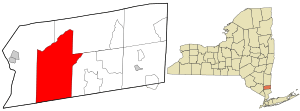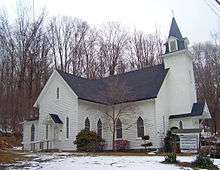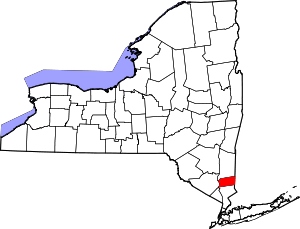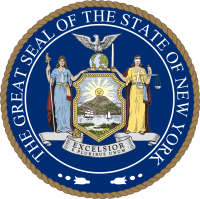Putnam Valley, New York
Putnam Valley is a town in Putnam County, New York, United States. The population was 11,809 at the 2010 census.[3] Its location is northeast of New York City, in the southwest part of Putnam County. Many residents of Putnam Valley commute to New York City daily for work or recreational purposes (Midtown Manhattan is around a forty five to fifty minute drive). Putnam Valley calls itself the "Town of Lakes".
Putnam Valley, New York | |
|---|---|
Town | |
| Nickname(s): Town of Lakes | |
 Location of Putnam Valley in New York | |
| Coordinates: 41°22′52″N 73°50′58″W | |
| Country | United States |
| State | New York |
| County | Putnam |
| Area | |
| • Total | 42.78 sq mi (110.80 km2) |
| • Land | 41.17 sq mi (106.64 km2) |
| • Water | 1.60 sq mi (4.16 km2) |
| Elevation | 564 ft (172 m) |
| Population (2010) | |
| • Total | 11,809 |
| • Estimate (2016)[2] | 11,616 |
| • Density | 282.11/sq mi (108.93/km2) |
| Time zone | UTC-5 (Eastern (EST)) |
| • Summer (DST) | UTC-4 (EDT) |
| ZIP code | 10579 |
| Area code(s) | 845 |
| FIPS code | 36-60147 |
| GNIS feature ID | 0979403 |
| Website | http://www.putnamvalley.com |
History
The retreating glaciers of the last ice age did much to shape the landscape of Putnam Valley, including the shearing of hills to expose springs (creating, for example Bryant Pond) and leaving the glacial deposits of stone and large boulders. The current area of Putnam Valley was occupied by paleo-Indians followed by the historic Wappinger Indians who lived by the many lakes. Dutch and English farmers moved into the area toward the end of the 17th Century.[4]
In 1697, the Highland Patent was granted to Adolph Philipse. The first settlers arrived around 1740. In 1745 the Smith property was sold to the Bryant family, who renamed their pond Bryant Pond and the nearby hill, Bryant Hill. The Smith family homestead is the oldest house in Putnam Valley, located just east of the Taconic Parkway on Bryant Pond Road.
Putnam Valley incorporated in 1839 as the town of Quincy, when it was separated from the town of Philipstown, and it took the name "Putnam Valley" in 1840, possibly because local inhabitants were not favorably impressed by John Quincy Adams.[4]
In 1861, a small part of the town of Carmel was added to Putnam Valley.
Geography
According to the United States Census Bureau, the town has a total area of 43.0 square miles (111 km2), of which 41.4 square miles (107 km2) is land and 1.6 square miles (4.1 km2), or 3.72%, is water. 14,089 acres of Clarence Fahnestock State Park lies within the boundaries of Putnam Valley and 1,000 acres is owned by the Hudson Highlands Land Trust, an environmental preservation trust in the Hudson Valley[5]
The south town line is the border of Westchester County.
The Taconic State Parkway passes through the eastern part of the town.
Demographics
| Historical population | |||
|---|---|---|---|
| Census | Pop. | %± | |
| 1840 | 1,659 | — | |
| 1850 | 1,626 | −2.0% | |
| 1860 | 1,587 | −2.4% | |
| 1870 | 1,566 | −1.3% | |
| 1880 | 1,555 | −0.7% | |
| 1890 | 1,193 | −23.3% | |
| 1900 | 1,034 | −13.3% | |
| 1910 | 924 | −10.6% | |
| 1920 | 704 | −23.8% | |
| 1930 | 859 | 22.0% | |
| 1940 | 1,187 | 38.2% | |
| 1950 | 1,908 | 60.7% | |
| 1960 | 3,070 | 60.9% | |
| 1970 | 5,209 | 69.7% | |
| 1980 | 8,994 | 72.7% | |
| 1990 | 9,094 | 1.1% | |
| 2000 | 10,686 | 17.5% | |
| 2010 | 11,809 | 10.5% | |
| Est. 2016 | 11,616 | [2] | −1.6% |
| U.S. Decennial Census[6] | |||

At the 2000 census,[7] there were 10,686 people, 3,676 households and 2,874 families residing in the town. The population density was 258.2 per square mile (99.7/km²). There were 4,253 housing units at an average density of 102.7 per square mile (39.7/km²). The racial makeup of the town was 94.54% White, 1.60% African American, 0.19% Native American, 0.85% Asian, 1.28% from other races, and 1.53% from two or more races. Hispanic or Latino of any race were 6.28% of the population.
There were 3,676 households of which 39.4% had children under the age of 18 living with them, 67.1% were married couples living together, 8.0% had a female householder with no husband present, and 21.8% were non-families. 17.1% of all households were made up of individuals and 4.8% had someone living alone who was 65 years of age or older. The average household size was 2.89 and the average family size was 3.28.
Age distribution was 26.7% under the age of 18, 6.0% from 18 to 24, 31.5% from 25 to 44, 27.1% from 45 to 64, and 8.7% who were 65 years of age or older. The median age was 38 years. For every 100 females, there were 99.3 males. For every 100 females age 18 and over, there were 98.2 males.
The median household income was $72,938, and the median family income was $82,576. Males had a median income of $56,976 versus $36,875 for females. The per capita income for the town was $31,215. About 2.7% of families and 4.8% of the population were below the poverty line, including 6.4% of those under age 18 and 1.7% of those age 65 or over.
Education
The Putnam Valley Central School District operates three schools: Putnam Valley Elementary School starting at kindergarten, Putnam Valley Middle School starting at 5th grade, and Putnam Valley High School starting at 9th grade.[8] The district was created in 1934, and was dedicated in 1935.[9]
The high school is the most recent addition to the district, being built in 2000. It uses geothermal energy for heating and cooling, has three computer labs, a performing arts center and wireless Internet access in all classrooms. Before the high school was built, Putnam Valley students were previously sent to neighboring town high schools including Lakeland High School in Shrub Oak, Peekskill High School or Walter Panas High School.[4]
Grades 5 through 12, every student is issued an Apple laptop or Chromebook, a program that sets the school apart from others in the area. The Putnam Valley High School's laptop agreement form reads, "Putnam Valley Central School District issues computers and school monitored email accounts as one way of furthering its mission to teach the skills, knowledge, responsibilities, and behaviors that students will need as successful and responsible adults".[10]
Government
The Town of Putnam Valley is governed by a town board. The town board consists of a Supervisor, Sam Oliverio, Jr. and four town board members: Jacqueline Annabi, Louie Luongo, Ralph Smith, and Wendy Whetsel.[11] The town hall is located at 265 Oscawana Lake Road in Putnam Valley. Law enforcement services for Putnam Valley are provided by the New York State Police and the Putnam County Sheriff's Department. Fire protection is provided by the Putnam Valley Volunteer Fire Department.
Communities and locations in Putnam Valley
- Adams Corners – A hamlet in the southeast part of the town.
- Amen Hill – A hill inside the Putnam Valley Park, known for its steep slope.
- Appalachian Trail – The Appalachian Trail runs through the town of Putnam Valley.
- Bullet Hole – A hamlet by the east town line.
- California Hill State Forest
- Christian Corners – A hamlet north of Oscawana Lake.
- Clarence Fahnestock State Park – A state park partly in the north part of the town.
- Crofts Corners – A hamlet in the south half of the town.
- Dennytown Lake – Historic lake in the hamlet of Dennytown.
- Dennytown – A hamlet near the west town line.
- Floradan Estates – A privately owned cooperative community located just south of the Town Park.
- Gilbert Corners – A hamlet west of Oscawana Lake.
- Lake Peekskill – A hamlet near the south town line that includes a small body of water called Lake Peekskill.
- Oscawana Corners – A hamlet south of Oscawana Lake.
- Oscawana Lake – A lake in the center of the town.
- Putnam Valley Town Park – A town park primarily in the southern part of town.
- Roaring Brook Lake – A hamlet around Roaring Brook Lake, east of the Taconic State Parkway.
- Roaring Brook – Historic stream running through the town and across the Taconic State Parkway. Flows into Roaring Brook Lake.
- Sunnybrook – A hamlet by the southwest shore of Oscawanna Lake.
- Three Arrows Cooperative Society – A cooperative colony near Shrub Oak.
- Tompkins Corners – A hamlet in the eastern part of the town. The United Methodist Church there, now closed, is the only building in town listed on the National Register of Historic Places.
References
- "2016 U.S. Gazetteer Files". United States Census Bureau. Retrieved Jul 5, 2017.
- "Population and Housing Unit Estimates". Retrieved June 9, 2017.
- "Profile of General Population and Housing Characteristics: 2010 Demographic Profile Data (DP-1): Putnam Valley town, Putnam County, New York". United States Census Bureau. Retrieved June 14, 2012.
- Raskyn, Terry (18 March 1990). "If You're Thinking of Living in: Putnam Valley". The New York Times.
- Hodara, Susan (6 February 2019). "Putnam Valley, N.Y.: Quiet, Rustic and Old-Timey". The New York Times.
- "Census of Population and Housing". Census.gov. Retrieved June 4, 2015.
- "U.S. Census website". United States Census Bureau. Retrieved 2008-01-31.
- https://www.nytimes.com/2008/09/14/realestate/14livi.html
- https://putnamvalleyhistory.org/about/
- http://pvcsd.org/HS/resources/pdf/2017-2018_Laptop_and_Mobile_Device_Loan_Agreement.pdf
- http://www.putnamvalley.com/town-board/

